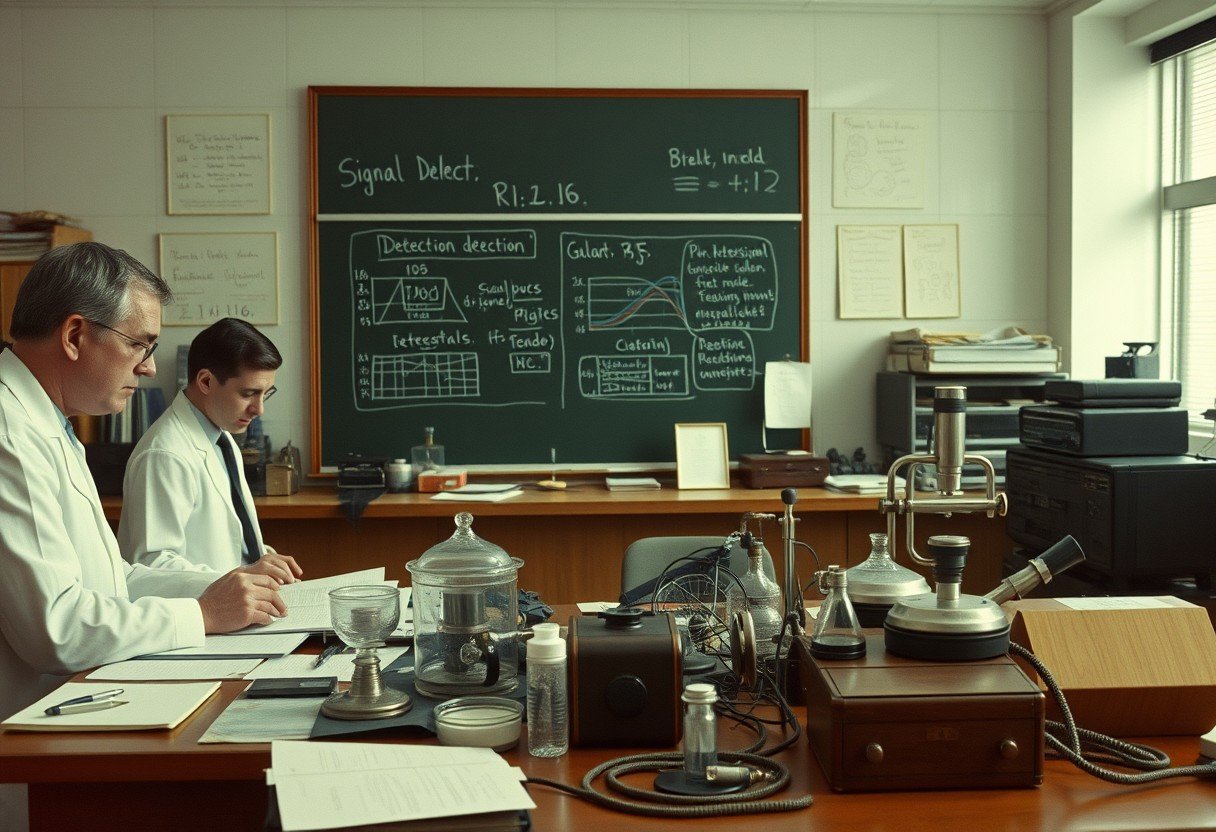Signal Detection Theory explains how people tell signals from noise, where choices are uncertain. It began in labs, moved into clinics and control rooms, and guides how we set cutoffs and judge risk. In 1964, John A. Swets and colleagues showed how to measure sensitivity and bias, and why that matters for truth and error. Use this guide to learn what it is, how it works, and why it still helps today.
What Signal Detection Theory Was Built To Solve
Many tasks are hard because signals are faint and noise is strong. A doctor reading a scan, a listener hearing a tone, or a guard watching a screen all face the same problem. They must decide yes or no when evidence is unclear.
Signal Detection Theory was built to judge decisions under uncertainty by separating sensitivity from response bias. This lets us tell whether poor performance comes from weak evidence or from a cautious or risky style of responding.
Before this work, psychology leaned on simple thresholds. People were said to detect a signal only if it was above a fixed limit. SDT showed that decision and perception are linked, and that payoffs and costs shift choices even when sensation is the same.
With SDT, we study behavior across many trials, count hits and false alarms, and map how a person trades misses for false alarms as the decision rule moves.
The Role Of Swets And The 1964 Breakthrough
John A. Swets helped bring radar ideas into human judgment. In the late 1950s and early 1960s, he and partners studied how people detect faint signals in noise in labs and clinics. The key step in 1964 was to apply clear math to messy human data.
Swets showed that the same tools that judged radar could judge readers of X rays and listeners of tones. The message was simple and powerful. We can compare observers and systems even when they use different cutoffs.
Work with David Green and others led to classic results on sensitivity, bias, and curves that show trade offs. Their reports and the 1966 book with Green helped move SDT into mainstream psychophysics and medical testing.
By placing accuracy and bias on separate axes, Swets gave a fair way to measure skill across fields such as hearing, vision, and diagnosis.
Core Parts Of The Theory Sensitivity And Criterion
Sensitivity tells how far apart the signal and noise are in the mind of the observer. A common index is d prime, which grows as signals become easier to tell from noise. Bias, or criterion, tells where the person sets the decision cutoff.
d prime measures the ability to separate signal from noise, while the criterion captures the tilt toward yes or no choices. This split matters because a bold observer can look skilled on raw accuracy even when sensitivity is low.
Change the costs and rewards, and people move their criterion. If misses are costly, they say yes more often. If false alarms are costly, they say no more often. Sensitivity can stay the same while choices shift.
In real tasks, unequal variance and context effects can bend the curves. Still, the two part view remains a clear map for design and evaluation.
Measuring Hits Misses False Alarms And Correct Rejections
Every decision falls into one of four outcomes. We count each type across many trials and compute rates. These rates feed into sensitivity and bias measures.
Reliable counts of hits and false alarms are the base for fair comparisons across observers and tests. With enough trials, estimates become stable and small changes in criterion are easier to see.
| Outcome | What It Means | Simple Example |
|---|---|---|
| Hit | Say signal when signal is present | Detects a tumor that is there |
| Miss | Say no signal when signal is present | Fails to detect a real tumor |
| False Alarm | Say signal when only noise is present | Calls a clear scan positive |
| Correct Rejection | Say no signal when only noise is present | Calls a clear scan negative |
With rates in hand, we can compute d prime and criterion, and draw curves that show the trade offs at all settings.
Receiver Operating Characteristic Curve And What It Shows
The ROC curve plots hit rate against false alarm rate at many cutoffs. A curve that bows toward the top left shows strong sensitivity. The area under the curve ranges from 0.5 for chance to near 1.0 for near perfect.
The ROC curve shows performance at every decision rule, so it is the best single view of accuracy without fixing a cutoff. It also lets us compare people and machines on common ground.
- Steeper early rise means better detection at low false alarm rates.
- Points along the curve reflect different costs and rewards for errors.
- Two curves can cross, which warns that no single cutoff suits all uses.
In clinics, ROC analysis guides how to set thresholds for tests like CT or PCR. In security, it helps tune alerts to meet safety goals without flooding users with false signals.
How To Apply SDT In Psychology And Diagnosis
Use SDT when you need a fair view of performance under noise. Plan your task, collect enough trials, and choose payoffs that match real costs. Then analyze both sensitivity and bias, not just raw accuracy.
A simple step by step plan turns messy choices into clear numbers you can trust. Follow the steps below and keep the design close to the real world task.
- Define the signal and the noise cases, and set trial counts for each.
- Run practice, then record yes or no responses on many trials.
- Compute hit and false alarm rates, then estimate d prime and criterion.
- Plot the ROC curve and choose a cutoff that fits the cost of errors.
- Report both sensitivity and bias with clear confidence intervals.
In medical testing, studies often report sensitivity, specificity, and ROC area. In human factors, teams test observers at several payoffs to see how bias moves. These habits make reports useful across sites and time.
Limits Critiques And Modern Updates
Classic SDT often assumes normal evidence with equal variance for noise and signal. Real data can break that rule, which changes curve shape and d prime values. Unequal variance models handle this better.
Human choices also depend on fatigue, training, and context, which classic SDT treats only through the criterion. Newer work adds models of attention and memory to capture these shifts.
Nonparametric ROC methods avoid strict shape rules and are robust with large samples. In machine learning, SDT ideas guide threshold tuning, precision recall trade offs, and cost sensitive training.
Across fields, the goal is the same. Keep sensitivity and bias separate, test at many cutoffs, and match the operating point to real costs and risks.
Practical Tips For Better Experimental Design
Balance your trials so that signal and noise counts are known and stable. Randomize order to prevent guess patterns. Make payoffs clear so the chosen criterion reflects true costs.
Collect enough observations to estimate rates with narrow error bars, especially when events are rare. Small samples make ROC points bounce and can hide the real curve.
Pre register the analysis plan, including how you will handle ties and outliers. Report confidence intervals for sensitivity, specificity, and ROC area so others can judge precision.
When results guide real actions, validate on a new sample. This checks that your curve and chosen cutoff hold up outside the lab.
FAQ
What Was The Original Focus Of Swets 1964 Signal Detection Theory?
The original focus was to separate sensitivity from decision bias so we can judge detection under uncertainty. It gave tools like ROC curves to compare observers and systems across many cutoffs.
How Do Hit Rate And False Alarm Rate Improve Test Evaluation?
They show how often true signals are caught and how often noise is called a signal. Together they support d prime, criterion, and ROC analysis that outperform simple accuracy.
Why Is The ROC Curve Better Than A Single Threshold?
It displays performance at every cutoff, which matches real trade offs in cost and risk. This lets users pick the operating point that fits their goal.
What Does d Prime Tell Me In Simple Terms?
d prime tells how far apart signal and noise are in mental evidence. Higher values mean easier detection and better separation.
Where Is Signal Detection Theory Used Today?
It is used in radiology, hearing tests, quality control, cybersecurity alerts, and machine learning threshold tuning. The same math helps choose cutoffs that fit each field.
How Many Trials Do I Need For Reliable ROC Estimates?
Plan for hundreds of trials if rates are near the extremes and at least dozens per condition in simple tasks. More trials lower error bars and smooth the curve.
What Are Common Mistakes When Applying SDT?
Using only accuracy, fixing a single cutoff, and ignoring class balance are common errors. Always report sensitivity, specificity, criterion, and ROC area with uncertainty.









Leave a Comment